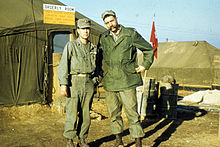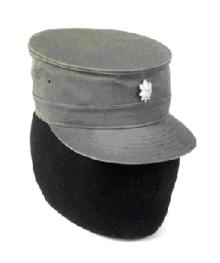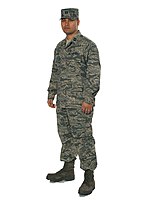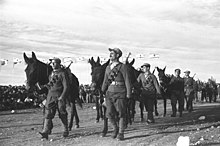
A patrol hat, also known as a field cap or soft cap, is a soft kepi constructed similarly to a baseball cap, with a stiff, rounded visor but featuring a flat top, worn by military personnel of some countries in the field when a combat helmet is not required.
History
U.S. Military
M1951 Field Cap and Ridgeway Cap

The M1951 Field Cap, introduced with the M1951 Uniform, was a derivative of the M1943 Field Cap, part of the M1943 Uniform. The M1951 cap was worn in the Korean War, where it became known as the "patrol cap" by the US Army Rangers there. It was constructed of wind-resistant olive-drab cotton poplin, and had a flannel wool panel that folded down to cover the ears and the back of the head. It was soft enough to be worn underneath an M1 helmet.

During the Korean War, the cap was replaced by the Ridgway Cap (named for General Matthew Ridgway), a stiffened version of the M1951 made by Falcon or Louisville Cap Company and known as the "Jump-Up" or "Spring-Up" cap. The hat became famous outside America after being worn by Fidel Castro. The patrol cap was replaced altogether in 1962 with a baseball-like "Cap, Field (Hot Weather)"; during the Vietnam War in-country troops were issued the boonie hat.
In 1980, the Army introduced the Battle Dress Uniform (BDU), which featured a patrol cap similar to the M1951 Field Cap, including the wool panel to cover the ears, except it was in Woodland camouflage. The BDU was replaced, starting in 2004, with the Army Combat Uniform (ACU).
Starting on June 14, 2001, Army Chief of Staff General Eric Shinseki made the black beret the standard headgear for Soldiers in the garrison environment, with the exception of Airborne, Ranger and Special Forces units, which had been authorized to wear their own unique berets since the early 1980s. On June 14, 2011, the M1951/ACU soft patrol cap became once again the primary headgear for all Soldiers as the duty uniform headgear after a 10-year hiatus in favor of the beret, according to Army Directive 2001-11.
Modern patrol caps
In 1981, following the introduction of the M81 Battle Dress Uniform, the patrol cap was reintroduced. The patrol cap continues to be worn with the Army Combat Uniform, introduced in 2004. The materials are 50% cotton, 50% nylon blend. It has been available in different variants and patterns, such as hot weather models which have eliminated the ear flaps. Patrol caps are frequently modified with a "Ranger Roll", inspired by a common practice by U.S. Army Rangers in the 75th Ranger Regiment, in which the sides of the cap are rolled downward, removing the rigid "flat" top; though this is against regulations. Other unauthorized, but common styles of wear include the "Duckbill", the "MLB" and the "Wash and Wear".
Patterns have included US Woodland, Six color desert camouflage (DBDU), Three color desert camouflage (DCU), Universal Camouflage Pattern (UCP), and Operational Camouflage Pattern (OCP). The ACU patrol cap features a velcro-backed patch on the back with the soldier's name printed on it and a small internal pocket, the soldier's rank insignia is pinned on the front, as seen in the image below.
-
 Two soldiers wearing the ACU, as well as a patrol cap (left) and boonie hat (right), both in the Universal Camouflage Pattern.
Two soldiers wearing the ACU, as well as a patrol cap (left) and boonie hat (right), both in the Universal Camouflage Pattern.
-
 USAF Captain wearing Airman Battle Uniform with digital tigerstripe-patterned patrol cap
USAF Captain wearing Airman Battle Uniform with digital tigerstripe-patterned patrol cap
Cuban Revolutionary Armed Forces

The Ridgeway Cap, a stiffened version of the M1951 Patrol Cap made famous after being worn by Fidel Castro, is a standard issue cap in the Cuban Revolutionary Army, and Cuban Revolutionary Air and Air Defense Force. American style patrol caps were worn by Cuban soldiers before, and during the Cuban Revolution. After the Revolution, the patrol cap kept being issued to Cuban military personnel. It is most commonly seen in solid color olive drab, but Cuban patrol caps with camouflage patterns like the grey lizard pattern have been made.
Israel Defense Forces
You can help expand this article with text translated from the corresponding article in Hebrew. (July 2015) Click for important translation instructions.
|

This style of military uniform cap was worn by the Muleteers' Battalion founded in January 1948 which was named for the British Army's Zion Mule Corps of the World War I, a forerunner of the Jewish Legion. The IDF adopted the "Kova Hitelmacher" for soldiers' uniforms in its early years.
Russia
The Russian army adopted the patrol cap when it adopted the woodland pattern Flora camouflage and then EMR camouflage VKBO uniforms in the early 2000s. There are two versions, a plain one worn by conscripts and a more elaborate one worn by kontrakniki and officers.
-
 Russian soldiers wearing the plain patrol cap on Victory Day 2011 in St Petersburg.
Russian soldiers wearing the plain patrol cap on Victory Day 2011 in St Petersburg.
-
 Russian troops, wearing the second more elaborate style of patrol cap, during 2022 Russian mobilization in Sevastopol's Nakhimov Square.
Russian troops, wearing the second more elaborate style of patrol cap, during 2022 Russian mobilization in Sevastopol's Nakhimov Square.
Gallery
-
 Lauri Törni in a Finnish M36 patrol cap.
Lauri Törni in a Finnish M36 patrol cap.
-
 Kersten Lahl in a patrol cap of the Bundeswehr.
Kersten Lahl in a patrol cap of the Bundeswehr.
See also
- Utility cover, the U.S. Navy and Marine Corps equivalent
- Side cap
- Jeep cap
References
- ^ CAP, FIELD, M-1951
- "M-1951 Cotton Field Cap".
- Field Cap
- Cap, Field (Hot Weather)
- M1951 Field Cap
- Army Directive 2011-11
- ^ Battle Dress Uniform (Bdu)
- ^ Army Combat Uniform (ACU)
- Moore, Nicholas; Bahmanyar, Mir (November 13, 2018). Run to the Sound of the Guns: The True Story of an American Ranger at War in Afghanistan and Iraq. Osprey Publishing. p. 27. ISBN 978-1472827067.
{{cite book}}: CS1 maint: date and year (link) - DePew, Doug (December 15, 2023). Recall! Return of the IRR. p. 94. ASIN B0CQFGC14F.
- ^ Knopf, Christina M. (2015). The Comic Art of War: a Critical Study of Military Cartoons, 1805/2014, With a Guide to Artists. Jefferson, North Carolina: McFarland & Company, Inc., Publishers. ISBN 978-0-7864-9835-2.
- Dougherty, Martin (2017). Camouflage at War: An Illustrated Guide from 1914 to the Present Day. Amber Books. p. 66. ISBN 978-1782744986.
| Hats and caps | |||||||||||||||||||||||||
|---|---|---|---|---|---|---|---|---|---|---|---|---|---|---|---|---|---|---|---|---|---|---|---|---|---|
| List of hat styles List of headgear | |||||||||||||||||||||||||
| Western culture |
| ||||||||||||||||||||||||
| Folk |
| ||||||||||||||||||||||||
| Wrapped headwear | |||||||||||||||||||||||||
| Hat parts | |||||||||||||||||||||||||
| Accessories | |||||||||||||||||||||||||